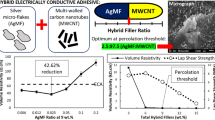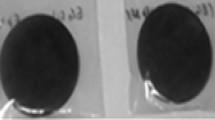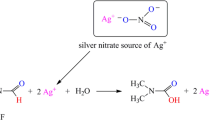Abstract
A combination of metal and non-metal filler in an epoxy resin, called a hybrid electrically conductive adhesive (ECA), is an important development in the field of highly conductive electronic interconnect materials. Carbon nanotubes (CNTs) are well known for contributing strength and stiffness to ECA and silver (Ag) has been widely used as a conductive metal. This study presents the characterization of a hybrid silver micro-flake (AgMF) with multiwalled carbon nanotubes (MWCNT) in an epoxy matrix ECA, in terms of electrical and mechanical properties. The weight percentage of AgMF used was varied, from 1 wt.% to 10 wt.%, whereas the weight percentage of MWCNT filler loading was maintained at 5 wt.%. The properties of the hybrid ECA were characterized using a four-point probe and a universal testing machine for lap shear tests. It was found that the filler hybridization lowered the performance of the ECA in terms of both electrical and mechanical properties, as compared with non-hybrid MWCNT-filled ECA. This may be attributed to the weak interaction between micro- and nano-filler particle sizes and agglomeration of the MWCNT in the epoxy matrix in the hybrid ECA system. The hybrid ECA electrical conductivity was successfully enhanced when a low ratio of AgMF and MWCNT was considered. In addition, failure analysis confirmed that the hybrid ECA with less AgMF filler loading exhibits improved adhesion strength, suggesting a superior epoxy-to-substrate bonding interface.
Similar content being viewed by others
References
G. Zhou, Y. Mao, C. Wang, S. Wang, Y. Chen, and W. He, J. Mater. Sci. Mater. Electron. 27, 9186 (2016).
J. Luo, C. Li, M. Chen, and Q. Li, Compos. Sci. Technol. 129, 191 (2016).
H.W. Cui and W.H. Du, J. Adhes. 89, 714 (2013).
F. Marcq, P. Demont, P. Monfraix, A. Peigney, Ch Laurent, T. Falat, F. Courtade, and T. Jamin, Microelectron. Reliab. 51, 1230 (2011).
Y.H. Ji, Y. Liu, G.W. Huang, X.J. Shen, H.M. Xiao, and S.Y. Fu, ACS Appl. Mater. Interfaces 7, 8041 (2015).
B.M. Amoli, A. Hu, N.Y. Zhou, and B. Zhao, J. Mater. Sci. Mater. Electron. 26, 730 (2015).
A. Martone, C. Formicola, F. Piscitelli, M. Lavorgna, M. Zarrelli, V. Antonucci, and M. Giordano, Express Polym. Lett. 6, 520 (2012).
T.P. Dyachkova, A.V. Rukhov, A.G. Tkachev, and E.N. Tugolukov, Adv. Mater. Technol. 2, 18 (2018).
Q. Fan, H. Cui, D. Li, Z. Hu, Z. Yuan, L. Ye, and J. Liu, in ICEPT-HDP Conference Proceedings (2011), pp. 423–425.
J. Zhu, H. Jin, M. Zhou, and X. Zhang, in ICEPT Conference Proceedings (2016), pp. 923–926.
J. Chen, J. Han, and D. Xu, Mater. Lett. 246, 20 (2019).
H. Dong, X. Li, Y. Dong, S. Guo, and L. Zhao, Materials 12, 1 (2019).
S. Li, X. He, J. Hao, J. Zhou, and F. Xue, in ICEPT Conference Proceedings (2017), pp. 275–279.
M. Liang and K.L. Wong, in ICEP Conference Proceedings (2016), pp. 162–167.
M. Rahmandoust and M.R. Ayatollahi, Advanced Structured Materials, Vol. 39 (Switzerland: Springer, 2016), p. 117.
F.V. Ferreira, B.R.C. Menezes, W. Franceschi, E.V. Ferreira, K. Lozano, L.S. Cividanes, A.R. Coutinho, and G.P. Thim, Fuller. Nanotub. Car. Nanostruct. 25, 531 (2017).
K. Mantena, J. Li, and J.K. Lumpp, in IEEE Aerospace Conference Proceedings (2008), pp. 1–5.
H. Xu, J. Al-Ghalith, and T. Dumitrică, Carbon 134, 531 (2018).
T.H. Nam, K. Goto, Y. Yamaguchi, E.V.A. Premalal, Y. Shimamura, Y. Inoue, K. Naito, and S. Ogihara, Compos. Part A Appl. Sci. Manuf. 76, 289 (2015).
S.U. Khan, J.R. Pothnis, and J.K. Kim, Compos. Part A Appl. Sci. Manuf. 49, 26 (2013).
T.H. Nam, K. Goto, Y. Yamaguchi, E.V.A. Premalal, Y. Shimamura, Y. Inoue, S. Arikawa, S. Yoneyama, and S. Ogihara, Compos. Part B Eng. 85, 15 (2015).
H. Ma, Z. Li, X. Tian, S. Yan, Z. Li, X. Guo, Y. Ma, and L. Ma, J. Electron. Mater. 47, 2929 (2018).
M. Oleksy, K. Szwarc-Rzepka, M. Heneczkowski, R. Oliwa, and T. Jesionowski, Materials 7, 6064 (2014).
L. Li and J.E. Morris, An Introduction to Electrically Conductive Adhesive (1998). http://web.cecs.pdx.edu/∼jmorris/Research%20&%20Publications/Electrically%20Conductive%20Adhesives/Int%20J%20Microelectronics%20Packaging%201%20(1998)%20159%20ICA%20Introduction.pdf. Accessed 3 March 2020.
M.M. Nasaruddin, Reliability performance of epoxy based electrically conductive adhesive with varying multiwalled carbon nanotube. Master Thesis, Universiti Teknikal Malaysia Melaka, Melaka, Malaysia (2019).
W.A. Rahman, S.H.S.M. Fadzullah, M.M. Nasaruddin, G. Omar, and M. B. Ramli in CAMMER Conference Proceedings (2018), pp. 46–47.
C.L. Poh, M. Mariatti, M.N. AhmadFauzi, O. Sidek, T.P. Chuah, and S.C. Chow, Proc. Chem. 19, 865 (2016).
J. Sow, S.H. Sheikh, M. Fadzullah, M.M. Nasaruddin, N.A. Masripan, M.R. Mansor, and M. Salim, in MERD Conference Proceedings (2019), pp. 1–2.
American Society for Testing and Materials. ASTM F390-98 (2003).
W. Zulhilmi, The functional properties of silver/carbon canotube hybrid composite. Bachelor Degree Thesis, Universiti Teknikal Malaysia Melaka, Melaka, Malaysia (2019).
M.M. Nasaruddin, S.H.S.M. Fadzullah, G. Omar, Z. Mustafa, M. Ramli, M.Z. Akop, I.S. Mohamad, and B. Çoşut, J. Adv. Manuf. Technol. 13, 133 (2019).
American Society for Testing and Materials. ASTM D 1002 (2005).
H.W. Cui, J.T. Jiu, K. Suganuma, and H. Uchida, RSC Adv. 5, 7200 (2015).
J. Trinidad, Evaluation of hybrid electrically conductive adhesives. Master Thesis, University of Waterloo, Ontario, Canada (2016).
K. Srinivas, M.S. Bhagyashekar, and B.G. Darshan, J. Polym. Compos. 6, 25 (2018).
M.M. Nasaruddin, S.H.S.M. Fadzullah, and G. Omar, Int. J. Recent Technol. Eng. 8, 28 (2019).
K. Srinivas, M.S. Bhagyashekar, and S.M. Mahesh, in ICCTEST Conference Proceedings (2017), pp. 182–188.
Y. Tijjani, F. Mohd Yasin, M.H.S. Ismail, and A.H. Mohamed Ariff, J. Ceram. Soc. Jpn. 126, 984 (2018).
R. Aradhana, S. Mohanty, and S.K. Nayak, J. Mater. Sci. Mater. Electron. 30, 4296 (2019).
A. Pantano, Carbon Nanotube-Reinforced Polymers, ed. R. Rafiee (Amsterdam: Elsevier, 2018), p. 201.
I. Taraghi, A. Fereidoon, and A. Mohyeddin, Steel Compos. Struct. 17, 825 (2014).
A. Gursel, A.A. Mohamad, and M.F.M. Nazerib, in IMSTEC Conference Proceedings (2019), pp. 108–114.
A.S. Subramanian, J.N. Tey, L. Zhang, B.H. Ng, S. Roy, J. Wei, and X. ‘Matthew’ Hu, Polymer 82, 285 (2015).
P. Jojibabu, G.D.J. Ram, A.P. Deshpande, and S. Rao, Polym. Degrad. Stab. 140, 84 (2017).
Acknowledgments
The authors would like to acknowledge the financial support from Zamalah Scheme under Universiti Teknikal Malaysia Melaka (UTeM) for this research work.
Author information
Authors and Affiliations
Corresponding author
Additional information
Publisher's Note
Springer Nature remains neutral with regard to jurisdictional claims in published maps and institutional affiliations.
Rights and permissions
About this article
Cite this article
Fadzullah, S.H.S.M., Adnan, Z., Omar, G. et al. Effect of Hybridization on the Functional Properties of AgMF–MWCNT-Filled Electrically Conductive Adhesive. J. Electron. Mater. 49, 6572–6581 (2020). https://doi.org/10.1007/s11664-020-08427-w
Received:
Accepted:
Published:
Issue Date:
DOI: https://doi.org/10.1007/s11664-020-08427-w




